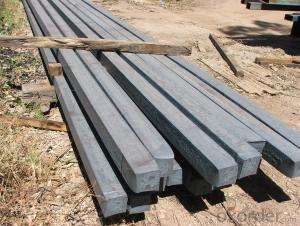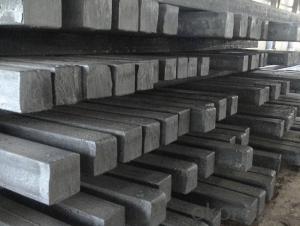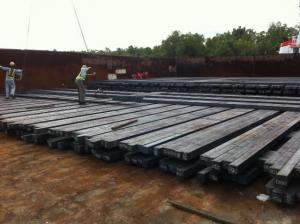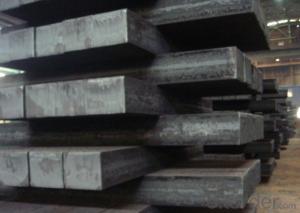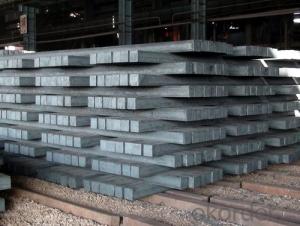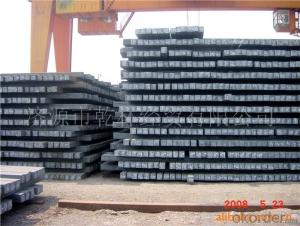Hot Rolled Square Steel Billet 3SP Standard 170mm
- Loading Port:
- Shanghai
- Payment Terms:
- TT OR LC
- Min Order Qty:
- 2000 m.t.
- Supply Capability:
- 10000 m.t./month
OKorder Service Pledge
OKorder Financial Service
You Might Also Like
Structure of Hot Rolled Square Steel Billet 3SP Standard 170mm

Description of Hot Rolled Square Steel Billet 3SP Standard 170mm
PPGI is made by cold rolled steel sheet and galvanized steel sheets as baseplate, through the surface pretreatment (degreasing, cleaning, chemical conversion processing), coated by the method of continuous coatings (roller coating method),
and after roasting and cooling. Zinc coating: Z60, Z80, Z100, Z120, Z180, Z275, G30, G60, G90
Alu-zinc coating: AZ60, AZ80, AZ100, AZ120, AZ180, G30, G60, G90
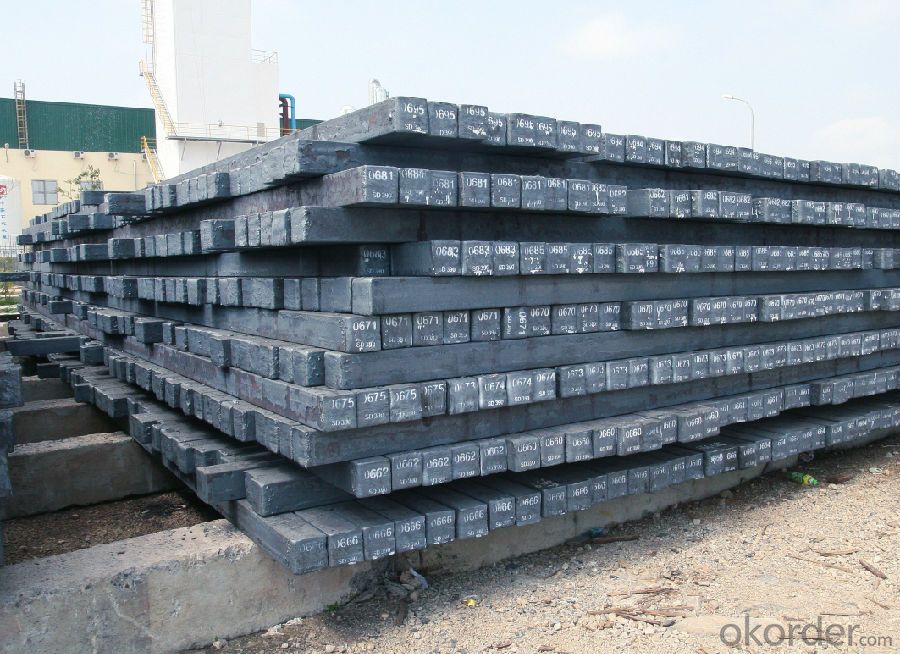
Main Feature of Hot Rolled Square Steel Billet 3SP Standard 170mm
1) Excellent corrosion resistance: The zinc layer provides a good protection of Pre-painted Galvanizeed Steel Sheet.
2) High heat resistance: The reflective surface of the material aids in efficiently reflecting the sunlight away and in turn reducing the amount of heat transmitted. The thermal reflectivity converts into energy savings.
3) Aesthetics: Pre-Painted Galvanized steel sheet is available in plethora of patterns and multiple sizes as per the requirements that given by our customers.
4) Versatility: can be used in the various areas.Standard seaworthy export packing: 3 layers of packing, inside is kraft paper, water plastic film is in the middle and outside GI steel sheet to be covered by steel strips with lock, with inner coil sleeve.
Applications of Hot Rolled Square Steel Billet 3SP Standard 170mm
1) Automotive bodies: filters, fuel tanks, etc.
2) Construction materials: roofings, welding pipes,
3) Electric and electronic appliances: computer cans, etc.
4) Steel cans: containers, etc.
5) Steel furniture: washing machines, refrigerators, microwaves, etc.
6) Drums
7) Office equipment: printer, recorders, etc.
8) Motors and transformers

Specifications of Hot Rolled Square Steel Billet 3SP Standard 170mm
| Classified symbol | Yield Point Minimum N/mm2 | Tensile Strength Minimum | Elongation Minimum % | Application | ||||
| N/mm2 | Nominal Thickness mm (t) | |||||||
| JIS | Yogic | 0.25-0.4 | 0.4-0.6 | 0.6-1.0 | 1.0-1.6 | |||
| G3312 | specification | |||||||
| CGCC | CGCC | -205 | -270 | -20 | -21 | -24 | -24 | Commercial |
| CGCD | CGCD | --- | 270 | --- | 27 | 31 | 32 | Drawing |
| --- | CG340 | 245 | 340 | 20 | 20 | 20 | 20 | Structural |
| CGC400 | CG400 | 295 | 400 | 16 | 17 | 18 | 18 | Structural |
| CGC440 | CG440 | 335 | 440 | 14 | 15 | 16 | 18 | Structural |
| CGC490 | CG490 | 365 | 490 | 12 | 13 | 14 | 16 | Structural |
| CGC570 | CG570 | 560 | 570 | --- | --- | --- | --- | Structural |
| ASTM Designation | Yield Point Minimum | Tensile Strength Minimum | Elongation Minimum % | Application | Q/BQB 445-2004(China standard) | ASM A653/A653M | JISG 3312 | |
| ksi(MPa) | ksi(MPa) | TDC51D+Z | (CS TYPE A+Z) | CGCC | ||||
| A653(M)-99 CS TYPE A,B,C | --- | --- | --- | Commercial | TDC52D+Z | CGCD | ||
| A653(M)-99 FS | --- | --- | --- | Lock Forming | TS250GD+Z | (G250+Z) | - | |
| A653(M)-99 DS | --- | --- | --- | Drawing | TS300GS+Z | (G300+Z) | CGC 400 | |
| A653(M)-99 SS Grade33(230) | 33(230) | 45(310) | 20 | Structural | TS350GD+Z | (G350+Z) | CGC490 | |
| A653(M)-99 SS Grade37(255) | 37(255) | 52(360) | 18 | Structural | TS550GD+Z | (G550+Z) | CGC570 | |
| A653(M)-99 SS Grade40(275) | 40(275) | 55(380) | 16 | Structural | ||||
| A653(M)-99 SS Grade50(345) | 50(345) | 65(450) | 12 | Structural | ||||
| A653(M)-99 SS Grade80(550) | 80(550) | 82(570) | --- | Structural | ||||
FAQ of Hot Rolled Square Steel Billet 3SP Standard 170mm
We have organized several common questions for our clients,may help you sincerely:
1. How Can I Visit There?
Our company is located in Tianjin City, China, near Beijing. You can fly to Tianjin Airport Directly. All our clients, from home or aboard, are warmly welcome to visit us!
2. How Can I Get Some Sample?
We are honored to offer you sample.
3. Why choose CNBM?
1, ISO, BV, CE, SGS approved.
2, Competitive price and quality.
3, Efficient service team online for 24 hours.
4, Smooth production ability(50000tons/month) .
5, quick delivery and standard exporting package.
6, Flexible payment with T/T, L/C, Paypal, Kunlun bank, etc.
- Q: What are the main factors that determine the demand for steel billets in different industries?
- The demand for steel billets in different industries is influenced by several factors. 1. Economic conditions: The overall state of the economy plays a crucial role in determining the demand for steel billets. During periods of economic growth and increased construction activities, there is typically a higher demand for steel billets in industries such as construction, infrastructure, and manufacturing. 2. Construction and infrastructure projects: The demand for steel billets is closely tied to construction and infrastructure projects. These projects require substantial amounts of steel for various purposes, including structural support, reinforcement, and fabrication. The level of investment in construction and infrastructure projects directly affects the demand for steel billets. 3. Manufacturing activities: Steel billets are used as raw material in various manufacturing processes, including automotive, aerospace, machinery, and equipment manufacturing. The demand for steel billets in these industries is directly influenced by the level of manufacturing activities and the overall production output. 4. Technological advancements: Technological advancements and innovation can also impact the demand for steel billets. As new technologies emerge and industries evolve, the demand for steel billets may change. For example, the rise of electric vehicles has increased the demand for steel billets in the automotive industry due to the need for lightweight yet strong materials. 5. International trade and globalization: The demand for steel billets can be affected by international trade dynamics and globalization. The expansion of global supply chains and the growth of emerging economies can lead to increased demand for steel billets in different regions. Changes in trade policies or tariffs can also influence the demand for steel billets in certain industries. 6. Environmental regulations: Increasing environmental regulations and sustainability initiatives can impact the demand for steel billets. Industries that are required to reduce their carbon footprint may opt for alternative materials or adopt more efficient manufacturing processes, which could affect the demand for steel billets. 7. Price and availability: The price and availability of steel billets can significantly impact demand. Fluctuations in steel prices, supply chain disruptions, or shortages of raw materials can influence the demand for steel billets in different industries. Additionally, the availability of substitutes or alternative materials can also affect the demand for steel billets. In conclusion, the demand for steel billets in different industries is influenced by economic conditions, construction and infrastructure projects, manufacturing activities, technological advancements, international trade, environmental regulations, and price and availability factors. Understanding these factors is essential for predicting and analyzing the demand for steel billets in various industries.
- Q: What are the different forging methods used for steel billets?
- There are several different forging methods commonly used for steel billets, including open die forging, closed die forging, and upset forging. Open die forging involves shaping the steel billet between flat or shaped dies, allowing for greater flexibility in forming complex shapes. Closed die forging, on the other hand, involves placing the billet between two dies that have a pre-determined shape, resulting in a more precise final product. Upset forging is a method used to increase the diameter or thickness of the billet by compressing it axially, often used to create shorter and thicker components.
- Q: How are steel billets used in the manufacturing of kitchen appliances?
- Steel billets are used in the manufacturing of kitchen appliances as the primary raw material. These billets are heated and then shaped or molded into various components such as bodies, frames, handles, or cooktops, which form the structural foundation of kitchen appliances. The high strength and durability of steel make it an ideal choice for withstanding the rigors of everyday use in kitchen appliances, ensuring their longevity and quality.
- Q: How are steel billets used in the production of aerospace structures?
- Steel billets are an essential component in the production of aerospace structures. These billets are typically made from high-quality steel and serve as the starting material for various aerospace components. They are used in forging, which is a manufacturing process that involves shaping the metal by applying compressive forces. Aerospace structures, such as aircraft frames, wing spars, landing gear components, and engine parts, require materials with exceptional strength, durability, and resistance to fatigue. Steel billets provide these qualities, making them ideal for the aerospace industry. The production of aerospace structures begins with the selection of the appropriate steel billets. These billets are carefully inspected to ensure they meet the required specifications and quality standards. Once approved, they undergo a series of processes, including heating, forging, and machining, to transform them into the desired shape and size. During the forging process, the steel billets are heated to a specific temperature and then subjected to intense pressure, either through hammering or pressing. This force causes the billets to deform and take the shape of the aerospace component being manufactured. The precise control of temperature and pressure ensures that the resulting structure has the desired mechanical properties and meets the stringent safety requirements of the aerospace industry. After forging, the aerospace structures are further machined and finished to achieve the necessary dimensional accuracy and surface quality. This may involve cutting, drilling, milling, and grinding processes. The steel billets' ability to withstand these machining operations without compromising their structural integrity is crucial in producing aerospace structures that meet the stringent performance standards. In summary, steel billets play a vital role in the production of aerospace structures by providing the necessary strength, durability, and fatigue resistance. Through forging and subsequent machining processes, these billets are transformed into various components, ensuring the structural integrity and safety of aerospace systems. The utilization of high-quality steel billets guarantees that the resulting structures meet the demanding requirements of the aerospace industry.
- Q: How are steel billets heat-treated?
- Steel billets are heat-treated using a process called annealing or quenching and tempering. Annealing involves heating the steel billets to a specific temperature and then slowly cooling them down. This process helps to relieve any internal stresses and improve the overall ductility and toughness of the steel. Quenching and tempering, on the other hand, involves heating the steel billets to a high temperature and then rapidly cooling them by immersing them in a quenching medium, such as water or oil. This rapid cooling creates a hard and brittle structure in the steel, which is then tempered by reheating the billets to a lower temperature. This tempering process helps to reduce the brittleness and increase the toughness of the steel billets. The specific heat treatment process used depends on the desired properties and applications of the steel billets.
- Q: What are the different types of steel billet surface treatment defects?
- There are several types of steel billet surface treatment defects that can occur during the manufacturing process. These defects can affect the quality and appearance of the steel billets, and it is important to identify and address them to ensure the overall performance of the final product. 1. Scale: Scale is a common defect that occurs when the steel billet is exposed to high temperatures during the manufacturing process. It appears as a layer of oxide on the surface of the billet, which can affect the adhesion of coatings or paints. 2. Inclusions: Inclusions are non-metallic particles or impurities that can be present on the surface of the steel billet. These inclusions can be caused by various factors, such as inadequate cleaning or improper handling during the manufacturing process. They can negatively impact the mechanical properties of the steel and reduce its overall performance. 3. Decarburization: Decarburization is a defect that occurs when the surface layer of the steel billet loses its carbon content due to exposure to high temperatures or a lack of protective atmosphere. This can lead to reduced hardness and strength in the affected area. 4. Pitting: Pitting is a localized defect that appears as small cavities or pits on the surface of the steel billet. It can be caused by the presence of impurities or by exposure to corrosive environments. Pitting can compromise the structural integrity of the billet and make it more susceptible to corrosion. 5. Surface cracks: Cracks can occur on the surface of the steel billet due to various factors, such as thermal stress, improper handling, or inadequate cooling. Surface cracks can weaken the billet and increase the risk of failure during subsequent processing or use. 6. Surface roughness: Surface roughness refers to an uneven or irregular surface texture on the steel billet. It can be caused by factors such as improper machining, inadequate cleaning, or the presence of scale or inclusions. Surface roughness can affect the appearance of the billet and may also impact its performance in certain applications. Overall, it is crucial to identify and address these surface treatment defects to ensure the quality and reliability of steel billets. Proper manufacturing processes, including adequate cleaning, protective atmospheres, and appropriate handling, can help minimize the occurrence of these defects and ensure the optimal performance of the final product.
- Q: What are the different surface treatments for improved surface hardness in steel billets?
- There are several different surface treatments that can be used to improve the surface hardness of steel billets. These treatments are designed to enhance the wear resistance and durability of the steel, making it suitable for various industrial applications. One common surface treatment method is through carburizing. Carburizing involves introducing carbon into the surface of the steel billet by heating it in a carbon-rich atmosphere, such as methane or propane. This process forms a hard layer of high-carbon steel on the surface, known as a case, which significantly increases the surface hardness of the billet. Another surface treatment technique is nitriding. Nitriding is a process that involves exposing the steel billet to a nitrogen-rich atmosphere at elevated temperatures. This causes nitrogen atoms to diffuse into the surface of the steel, forming a hard nitride layer. Nitriding not only improves surface hardness but also enhances the resistance to wear and corrosion. A third surface treatment method is induction hardening. Induction hardening utilizes the principle of electromagnetic induction to heat the surface of the steel billet rapidly. Once the desired temperature is reached, the billet is quenched, resulting in a hardened surface layer. This treatment is particularly effective for localized hardening of specific areas on the steel billet. Additionally, shot peening is another surface treatment technique used to improve surface hardness. Shot peening involves bombarding the surface of the steel billet with small, high-velocity steel shots. This process induces compressive stresses in the surface layer, thereby increasing the hardness and fatigue resistance of the billet. Each of these surface treatments has its advantages and disadvantages, and the choice of treatment method depends on the specific requirements and intended use of the steel billets. By selecting an appropriate surface treatment, manufacturers can ensure that steel billets possess the necessary hardness and durability for their intended applications.
- Q: What are the different types of casting processes used for shaping steel billets?
- There are several different types of casting processes used for shaping steel billets. These processes include: 1. Continuous Casting: This is the most commonly used method for casting steel billets. In this process, molten steel is poured into a water-cooled mold that is continuously moving. As the steel solidifies, it is continuously pulled out of the mold, resulting in a continuous billet. This process is efficient and allows for high production rates. 2. Centrifugal Casting: In this process, molten steel is poured into a rotating mold. The centrifugal force generated by the rotation distributes the molten metal evenly along the mold walls, resulting in a cylindrical billet. This method is used to produce high-quality and defect-free billets. 3. Ingot Casting: This is a traditional method of casting steel billets. In this process, molten steel is poured into a mold and allowed to solidify. The solidified steel, known as an ingot, is then removed from the mold and further processed to obtain the desired shape of the billet. Ingot casting allows for flexibility in terms of billet shape and size. 4. Sand Casting: This process is used for producing large and complex steel billets. It involves creating a mold using a mixture of sand and a binder material. Molten steel is then poured into the mold, and once it solidifies, the mold is removed to reveal the billet. Sand casting allows for the production of custom-shaped billets but is a slower and less precise process compared to others. 5. Investment Casting: Also known as lost-wax casting, this process is suitable for complex and intricate shapes. In investment casting, a wax pattern of the desired billet shape is created. The wax pattern is then coated with a ceramic shell, and the wax is melted out, leaving behind a hollow mold. Molten steel is poured into the mold, and once it solidifies, the ceramic shell is broken to retrieve the billet. Each of these casting processes has its advantages and disadvantages, and the choice of process depends on factors such as the desired billet shape, size, production volume, and quality requirements.
- Q: What are the different methods used for heating steel billets?
- There are several different methods used for heating steel billets, depending on the specific requirements and constraints of the application. Some of the common methods include: 1. Induction Heating: This method uses electromagnetic induction to heat the steel billets. An alternating current is passed through a coil, creating a magnetic field that induces electrical currents in the billet, generating heat. Induction heating provides precise and controllable heating, allowing for uniform heating throughout the billet. 2. Gas Furnaces: Gas furnaces utilize burners to generate heat, which is then transferred to the steel billets through convection. Natural gas or propane is commonly used as the fuel source. Gas furnaces offer flexibility in terms of temperature control, heating rate, and energy efficiency. 3. Electric Resistance Heating: In this method, electric current is passed through resistive elements, such as heating elements or heating pads, that are in direct contact with the steel billets. The resistance to the electric current generates heat, which is transferred to the billets. Electric resistance heating is commonly used for smaller-scale operations or applications with specific heating requirements. 4. Flame Heating: Flame heating involves the use of an open flame, typically generated by a gas burner, to heat the steel billets. The billets are heated by the radiant heat emitted from the flame. Flame heating is often used for larger billets or in applications where rapid heating is required. 5. High-Frequency Heating: High-frequency heating utilizes electromagnetic fields to heat the billets. The billets are placed inside a coil, and a high-frequency alternating current is passed through the coil, inducing electrical currents in the billets. The resistance to the electrical currents generates heat, resulting in rapid and uniform heating. 6. Laser Heating: Laser heating involves the use of high-powered lasers to heat the steel billets. The laser beam is focused on the surface of the billet, generating intense heat through the absorption of the laser energy. Laser heating offers precise and localized heating, making it suitable for specific applications or for heat treating small areas of the billets. These are just a few of the methods commonly used for heating steel billets. The choice of method depends on factors such as the required heating rate, temperature control, energy efficiency, and the specific characteristics of the billets being heated.
- Q: How are steel billets used in the manufacturing of pumps and compressors?
- Steel billets are used in the manufacturing of pumps and compressors as raw material for forging or machining various components such as impellers, casings, and shafts. These billets are shaped and processed into specific parts, ensuring the strength, durability, and performance required for these industrial equipment.
Send your message to us
Hot Rolled Square Steel Billet 3SP Standard 170mm
- Loading Port:
- Shanghai
- Payment Terms:
- TT OR LC
- Min Order Qty:
- 2000 m.t.
- Supply Capability:
- 10000 m.t./month
OKorder Service Pledge
OKorder Financial Service
Similar products
Hot products
Hot Searches
Related keywords



